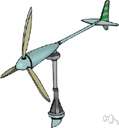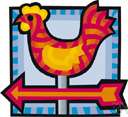vane
Also found in: Thesaurus, Medical, Encyclopedia, Wikipedia.
Related to vane: vain
vane
blade in a wheel moved by air, steam, or water: A weather vane shows the direction of the wind.; someone who is changeable or fickle
Not to be confused with:
vain – excessively proud of one’s appearance, qualities, etc.; conceited: She is very vain about her long black hair.; arrogant; egotistical; without effect or avail: Her efforts were in vain.; worthless; unimportant
vein – blood vessel; a natural channel; a body or stratum of ore: a rich vein of coal; a condition, mood, or temper: a vein of sadness; tone; touch; thread; streak
Abused, Confused, & Misused Words by Mary Embree Copyright © 2007, 2013 by Mary Embree
vane
(vān)n.
1. A weathervane.
2. Any of several usually relatively thin, rigid, flat, or sometimes curved surfaces radially mounted along an axis, as a blade in a turbine or a sail on a windmill, that is moved by or used to move a fluid.
3. The flattened, weblike part of a feather, consisting of a series of barbs on either side of the shaft.
4.
a. The movable target on a leveling rod.
b. A sight on a quadrant or compass.
5. One of the metal guidance or stabilizing fins attached to the tail of a bomb or other missile.
American Heritage® Dictionary of the English Language, Fifth Edition. Copyright © 2016 by Houghton Mifflin Harcourt Publishing Company. Published by Houghton Mifflin Harcourt Publishing Company. All rights reserved.
vane
(veɪn)n
1. (Mechanical Engineering) Also called: weather vane or wind vane a flat plate or blade of metal mounted on a vertical axis in an exposed position to indicate wind direction
2. (Mechanical Engineering) any one of the flat blades or sails forming part of the wheel of a windmill
3. (Mechanical Engineering) any flat or shaped plate used to direct fluid flow, esp a stator blade in a turbine, etc
4. (Mechanical Engineering) a fin or plate fitted to a projectile or missile to provide stabilization or guidance
5. (Zoology) ornithol the flat part of a feather, consisting of two rows of barbs on either side of the shaft
6. (Surveying) surveying
a. a sight on a quadrant or compass
b. the movable marker on a levelling staff
[Old English fana; related to Old Saxon, Old High German fano, Old Norse fani, Latin pannus cloth]
vaned adj
ˈvaneless adj
Vane
(veɪn)n
(Biography) Sir Henry, known as Sir Harry Vane. 1613–62, English Puritan statesman and colonial administrator; governor of Massachusetts (1636–37). He was executed for high treason after the Restoration
Collins English Dictionary – Complete and Unabridged, 12th Edition 2014 © HarperCollins Publishers 1991, 1994, 1998, 2000, 2003, 2006, 2007, 2009, 2011, 2014
vane
(veɪn)n.
2. any of a number of blades or plates attached radially to a rotating cylinder or shaft, as in a turbine or windmill, that move or are moved by a fluid, as steam or air.
3. a person who is readily changeable or fickle.
4.
a. (on a rocket) any fixed or movable surface providing directional control for atmospheric flight.
b. a similar plane surface in the exhaust jet of a reaction engine, providing directional control while the engine is firing.
5. the web of a feather.
[before 1100; Middle English; Old English fana flag, c. Old Saxon, Old High German fano, Old Norse -fani flag, cloth]
Vane
(veɪn)n.
Sir Henry (Sir Harry Vane), 1613–62, British statesman and author.
Random House Kernerman Webster's College Dictionary, © 2010 K Dictionaries Ltd. Copyright 2005, 1997, 1991 by Random House, Inc. All rights reserved.
ThesaurusAntonymsRelated WordsSynonymsLegend:
Switch to new thesaurus
| Noun | 1. |  vane - mechanical device attached to an elevated structure; rotates freely to show the direction of the wind vane - mechanical device attached to an elevated structure; rotates freely to show the direction of the windmechanical device - mechanism consisting of a device that works on mechanical principles weathercock - weathervane with a vane in the form of a rooster wind tee - weather vane shaped like a T and located at an airfield |
| 2. |  vane - a fin attached to the tail of an arrow, bomb or missile in order to stabilize or guide it vane - a fin attached to the tail of an arrow, bomb or missile in order to stabilize or guide itarrow - a projectile with a straight thin shaft and an arrowhead on one end and stabilizing vanes on the other; intended to be shot from a bow fin - a stabilizer on a ship that resembles the fin of a fish missile - a rocket carrying a warhead of conventional or nuclear explosives; may be ballistic or directed by remote control | |
| 3. |  vane - flat surface that rotates and pushes against air or water vane - flat surface that rotates and pushes against air or waterfan blade - blade of a rotating fan eggbeater, helicopter, whirlybird, chopper - an aircraft without wings that obtains its lift from the rotation of overhead blades impeller - the blade of a rotor (as in the compressor of a jet engine) oar - an implement used to propel or steer a boat paddle - a blade of a paddle wheel or water wheel rotating mechanism - a mechanism that rotates rudder blade - the vertical blade on a rudder turbine - rotary engine in which the kinetic energy of a moving fluid is converted into mechanical energy by causing a bladed rotor to rotate | |
| 4. |  vane - the flattened weblike part of a feather consisting of a series of barbs on either side of the shaft vane - the flattened weblike part of a feather consisting of a series of barbs on either side of the shaftfeather, plumage, plume - the light horny waterproof structure forming the external covering of birds barb - one of the parallel filaments projecting from the main shaft of a feather blade - a broad flat body part (as of the shoulder or tongue) |
Based on WordNet 3.0, Farlex clipart collection. © 2003-2012 Princeton University, Farlex Inc.
Translations
déflecteur de volet
vane
[veɪn] N (= weather vane) → veleta f; [of mill] → aspa f; [of propeller] → paleta f; [of feather] → barbas fplCollins Spanish Dictionary - Complete and Unabridged 8th Edition 2005 © William Collins Sons & Co. Ltd. 1971, 1988 © HarperCollins Publishers 1992, 1993, 1996, 1997, 2000, 2003, 2005
vane
n (also weather vane) → Wetterfahne f, → Wetterhahn m; (of windmill) → Flügel m; (of propeller) → Flügel m, → Blatt nt (of turbine) → (Leit)schaufel f
Collins German Dictionary – Complete and Unabridged 7th Edition 2005. © William Collins Sons & Co. Ltd. 1980 © HarperCollins Publishers 1991, 1997, 1999, 2004, 2005, 2007
Collins Italian Dictionary 1st Edition © HarperCollins Publishers 1995